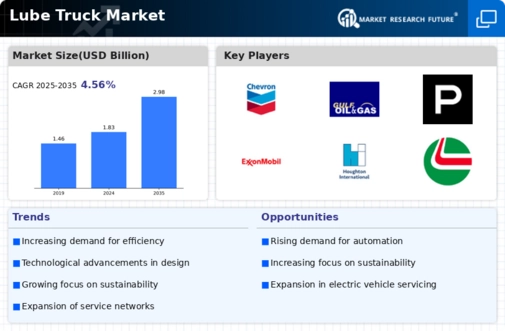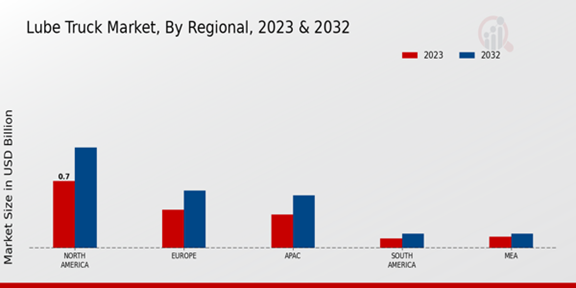Market Growth Projections
The Global Lube Truck Market Industry is poised for substantial growth, with projections indicating a market size of 1.83 USD Billion in 2024 and an anticipated increase to 2.98 USD Billion by 2035. This growth trajectory suggests a compound annual growth rate (CAGR) of 4.54% from 2025 to 2035. Such figures reflect the increasing reliance on lube trucks across various sectors, driven by the need for efficient lubrication solutions and advancements in technology. The market's expansion is indicative of broader trends in industrial maintenance and operational efficiency.
Expansion of Oil and Gas Sector
The expansion of the oil and gas sector is a key driver of the Global Lube Truck Market Industry. As exploration and production activities increase, the demand for reliable lubrication solutions to support heavy machinery and equipment rises correspondingly. Lube trucks are essential for providing on-site lubrication services, ensuring that equipment operates optimally in challenging environments. This trend is expected to continue, with the market projected to reach 2.98 USD Billion by 2035, highlighting the critical role that lube trucks play in supporting the oil and gas industry's operational needs.
Growing Focus on Preventive Maintenance
The emphasis on preventive maintenance across industries significantly drives the Global Lube Truck Market Industry. Organizations recognize that regular lubrication is essential for prolonging the lifespan of machinery and reducing the risk of breakdowns. This proactive approach to maintenance is particularly prevalent in sectors such as mining and agriculture, where equipment reliability is critical. The increasing awareness of the benefits of preventive maintenance is likely to contribute to the market's growth, as companies invest in lube trucks to ensure their equipment operates smoothly and efficiently, thereby reducing overall operational costs.
Technological Advancements in Lube Truck Design
Technological advancements play a crucial role in shaping the Global Lube Truck Market Industry. Innovations in design and functionality enhance the efficiency and reliability of lube trucks, making them indispensable for various applications. Features such as automated dispensing systems, real-time monitoring, and improved fuel efficiency are increasingly integrated into modern lube trucks. These advancements not only optimize performance but also contribute to cost savings for operators. As a result, the market is expected to grow at a CAGR of 4.54% from 2025 to 2035, indicating a strong trend towards adopting advanced technologies in lube truck operations.
Rising Demand for Efficient Lubrication Solutions
The Global Lube Truck Market Industry experiences a notable increase in demand for efficient lubrication solutions across various sectors, including automotive, construction, and manufacturing. As industries strive for enhanced operational efficiency, the need for timely and effective lubrication becomes paramount. This trend is particularly evident in the automotive sector, where the integration of lube trucks facilitates quick servicing and minimizes downtime. The market is projected to reach 1.83 USD Billion in 2024, reflecting a growing recognition of the importance of maintaining machinery and vehicles through effective lubrication practices.
Environmental Regulations and Sustainability Initiatives
The Global Lube Truck Market Industry is influenced by increasing environmental regulations and sustainability initiatives. Governments worldwide are implementing stricter regulations regarding emissions and waste management, prompting industries to adopt more sustainable practices. Lube trucks equipped with eco-friendly lubricants and waste management systems are becoming more prevalent as companies seek to comply with these regulations. This shift towards sustainability not only helps in meeting legal requirements but also enhances corporate responsibility. As industries prioritize environmental stewardship, the demand for lube trucks that align with these initiatives is likely to grow.






















Leave a Comment